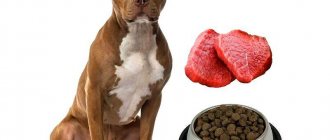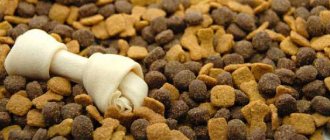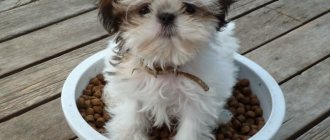Beagles are a popular breed of hound and are kind and loyal dogs. They are completely unpretentious in food, but have one peculiarity. These dogs are excellent manipulators. They resort to various tricks to beg a tidbit from the owner.
Beagles are prone to obesity, so the owner should not follow the lead of a charming pet. Only by carefully controlling the diet can you raise an active and, most importantly, healthy friend.
The basis of the beagle's diet
Dogs are carnivorous animals, so the majority of their diet should consist of meat products.
Beagles can be fed:
- lean meat - beef, turkey, rabbit;
- by-products - heart, lungs, tripe, liver.
You should avoid pork, lard and other fatty foods. It is poorly digested and leads to excess weight gain.
The meat is given raw, having first been frozen for 2-3 days or scalded with boiling water to destroy parasites and pathogenic bacteria. By-products must be cooked.
Cereals
Classically, a set of safe and easily digestible dog cereals consists of: oatmeal, rice, buckwheat and wheat cereal. It is not advisable to give other types of cereals, since they are poorly absorbed by the dog’s body. This is especially true for semolina, pearl barley, millet, barley and corn grits. Cook porridge using water or vegetable broth. Fatty meat broth is not advisable to use for this purpose. Any fatty food is contraindicated for dogs, as it can cause inflammation of the digestive system and lead to obesity. The exception is winter, when long walks in the cold require more energy. You can add boiled meat, vegetables, herbs, raw vegetable oil or an egg (boiled or raw) to the finished porridge.
What type of food to choose
Beagles are fed either natural products or commercial food. Mixing both diets is not recommended. The digestive system adapts to a certain type of food and begins to produce appropriate enzymes. Sudden changes lead to indigestion.
If the owner wants to switch his beagle from dry food to natural food, or vice versa, he needs to act gradually. The transition takes about 2 weeks - first replace 1/4 of the portion, after 3-4 days - 1/2, etc.
Important. It is advisable to choose the type of food before the beagle turns one year old. It will be more difficult for an adult body to adapt.
Ready-made dog food
Eating ready-made food - dry granules and canned food - is not as labor-intensive as preparing natural food. The owner is freed from the need to stand at the stove every day and buy food for the pet.
High-quality ready-made food has a balanced composition, therefore it fully covers the body’s needs for nutrients. With this type of diet, the beagle does not need vitamin and mineral supplements.
You can always keep a supply of dry food at home without fear that it will spoil. It is convenient to take with you on the road, which is a significant advantage for owners of show animals and travel lovers.
However, dogs can only be fed premium and super premium class or holistic products. Cheap food, which is sold in every store, is dangerous to health if consumed frequently.
The low price is due to the low quality of the ingredients. Economy class food does not contain natural meat (it is replaced with meat waste), but there are many artificial additives and ballast substances.
It is preferable to feed your beagle the following brands:
- Royal Canin;
- Monge;
- 1st Choice;
- Hills;
- Bosch;
- Advance;
- Orijen;
- Acana;
- Pro Plan;
- GO! NATURAL Holistic;
- Happy Dog.
Food for a beagle is selected taking into account its age and condition. There are separate lines for sale for puppies, pregnant and lactating females, elderly and sick dogs.
For your information. It is allowed to alternate canned food and dry food from the same manufacturer.
Natural products
Proponents of natural nutrition believe that it is more natural for dogs. With this approach, the owner is sure that the beagle is feeding high-quality and fresh foods that do not contain dyes, preservatives or other harmful additives.
The natural menu is more varied. The Beagle does not get tired of the taste of the same food, which reduces the likelihood of whims and food refusals. In addition, when feeding “natural” it is easy to exclude any product if the pet develops an allergy.
In addition to meat and offal, which account for at least 50% of the total food, beagles are fed rice and buckwheat porridge. They provide energy and contain fiber necessary for proper digestion.
It is advisable to add a tablespoon of vegetable oil to the porridge - this is a source of unsaturated fatty acids.
The daily menu must include fermented milk products - kefir, cottage cheese, fermented baked milk, yogurt, bifidok. Milk is given only to puppies, since adult animals no longer digest it.
Another important component of the diet is fresh herbs and vegetables.
Beagles can be fed:
- dill;
- parsley;
- lettuce leaves;
- pumpkin;
- carrots;
- zucchini;
- cauliflower.
Vegetables are mixed into porridges or given separately in the form of salads, which are seasoned with low-fat sour cream or vegetable oil.
Once a week, beagles are fed boiled sea fish - flounder, halibut, pink salmon and others. Fish contains vitamins, iodine and phosphorus. With regular use, the condition of the skin and joints of animals improves, and the coat becomes thicker and softer.
Twice a week an egg is mixed into food - chicken, quail, goose. This product is rich in folic acid, proteins, amino acids and minerals. It is better to boil eggs because they may be contaminated with dangerous bacteria.
As treats, beagles are given fruits (apples, pears, peaches, bananas), rye crackers, and pieces of low-fat cheese.
Choosing a place, dishes and accessories for feeding
Beagles are quite capricious dogs, and are famous for the fact that they like to dictate to their owners the rules of behavior in the house. This, in particular, affects the reluctance to have a dedicated place for rest and other aspects of behavior related to the manifestation of anarchic habits.
In this regard, determining the place where the puppy will eat will organize and discipline the little bully, and a diet in which the owner eats first will help develop the correct behavioral patterns in the beagle.
The place for feeding is chosen so that all family members feel comfortable:
- Away from the aisle (so that no one could accidentally step on the baby or push him).
- Where it is easier to clean up (in case the puppy knocks over the bowl).
You should not place the bowl in the kitchen if it is too crowded, or near the dog’s bed. The dishes for feeding the beagle puppy are chosen so that the pet’s long ears do not get into it while eating.
There are several types of bowls:
- Plastic : convenient for travel, but poorly suited as permanent utensils - they are too light and “pleasing to the teeth.”
- Ceramic : convenient, you can heat food in the microwave, but their price is quite high.
- Metal : the best option, both in quality and price.
Bowls are selected according to age and change as the pet gets older. It is convenient for beagles to eat from deep bowls that are not too large in diameter. The dishes are placed on rubber mats or special stands for bowls (bars, countertops, bedside tables with drawers with holes for dishes). The feeding level is up to the pet’s elbows.
Important! It is advisable to choose a place for feeding immediately, and not change it as the dog grows older.
What not to feed
The dog's body is not designed to digest many types of food that are familiar to humans. Beagles are prohibited from feeding:
- chocolate, baked goods and other sweets;
- spicy, salty, spicy, fried, pickled dishes;
- sausages and smoked meats;
- freshwater fish;
- products containing dyes and preservatives;
- tubular bones;
- potatoes, pasta, legumes, mushrooms;
- raisins, grapes and citrus fruits;
- sorrel and rhubarb.
Under no circumstances should a beagle be fed spoiled food. Like a person, he can get poisoned.
Important. Drinks containing caffeine and other stimulants are prohibited.
How many times a day to feed
Your puppy's feeding schedule depends on his age. The younger the beagle, the more often it should receive food. In the first week of life, babies suckle from their mother up to 12 times a day. The frequency gradually decreases - by 2 months it is enough for them to drink milk about 5 times.
After moving to a new home, the puppy is fed in its usual way - 5-6 times a day. As you grow, portions are increased and the number of meals is reduced:
- from 4 months to six months – 4 times;
- from 6 months to a year – 3 times.
A one-year-old beagle is considered an adult. He is fed twice a day - morning and evening.
The daily volume of natural food is calculated using the formulas:
- 7–8% of beagle weight for puppies;
- 5–6% – for adult dogs.
The amount of food is adjusted depending on the pet's activity level. Food is divided into equal portions. It is preferable to feed your beagle less high-calorie foods in the first half of the day, and give hearty cereals before bed.
When feeding dry food, follow the recommendations on the packaging.
How to bathe?
You can bathe the puppy for the first time only after the end of the two-week quarantine after the 2nd vaccination and only in case of emergency.
Beagles should not be bathed too often - once every 3-4 months is enough; more frequent washing will lead to dry skin.
You also need to make sure that the water is not hot and does not get into the dog’s ears. The shampoo should be soft, preferably moisturizing, intended for dogs.
Important! You cannot bathe your dog using human shampoos - they dry out your pet's skin, because... The pH of human skin is different from that of a dog.
What to feed a puppy
His health and longevity depend on what a puppy eats in the first year of life. A young body is forming and developing, so it especially needs a balanced diet.
Diet up to a year
In the first month, puppies have enough mother's milk - it contains all the necessary nutrients in the correct ratio. If the female has problems with lactation, the babies are fed with special mixtures that are sold in pet stores.
Baby food is not suitable because it does not meet the needs of the dog's body.
When Beagle puppies are one month old, complementary foods are introduced:
- boiled pieces of beef;
- milk;
- mashed boiled vegetables.
At 2 months, beagle puppies are usually handed over to new owners. To avoid digestive problems, you should check with the breeder in advance for a list of permitted products.
For your information. You can switch your beagle to high-quality dry puppy food. The granules are soaked in broth or kefir in advance so that they do not scratch tender gums.
At first, the baby is fed his usual food. After adaptation to the new location, the menu is enriched with:
- kefir;
- cottage cheese;
- chicken egg yolks (2 times a week);
- porridge.
At this age, proteins (meat and dairy products) make up approximately 70% of the total amount of food, vegetables and cereals - 30%.
The puppy is fed from a metal bowl, since plastic breaks easily - the beagle can swallow the fragments. The dishes are placed on an adjustable stand. As they grow, the height increases. Normally, the bowl should be at the level of the animal's shoulder.
Important. With a natural diet, the puppy must be given vitamin and mineral supplements.
At 3 months, you can feed your Beagle puppy sea fish. It is given instead of meat 1-2 times a week. The fish portion should be one third larger than the meat portion due to its low calorie content.
The meat is cut into larger pieces so that the baby can train his jaw muscles. Vegetables are no longer boiled and given raw.
As teeth begin to change, beagles include more calcium-rich foods in their diet. To facilitate the process and reduce discomfort, once a week the baby is allowed to gnaw on brain bones, cartilage and dental treats.
From 4 months, beagles are given offal a couple of times a week. New food is introduced very carefully, starting with 1 teaspoon. The total amount of protein is maintained at 70%, since it is the building material for muscle tissue.
From the age of 6 months, the beagle is fed almost the same as an adult dog. But the volume of food should be slightly larger. Milk is completely excluded because it ceases to be absorbed.
Diet for dogs over a year old
After a year, the beagle is fed all permitted foods. Portions are reduced slightly - the period of active growth has already ended.
Dogs are fed at the same time - then the gastrointestinal tract will work like clockwork. The bowl is removed 15–20 minutes after the start of feeding. The supplement is not given if the beagle has eaten the amount appropriate for its age. These measures prevent the appearance of excess weight.
Important. A beagle should not be fed before a walk or activity where it must move actively - this can lead to gastric volvulus and death.
If the beagle does gain weight, he is put on a diet:
- reduce the amount of porridge;
- beef is replaced with turkey;
- give more vegetables - carrots, pumpkins, zucchini;
- by-products are completely excluded;
- gradually increase physical activity.
It is advisable to consult a veterinarian - he will give individual recommendations on feeding.
When fed dry food, the beagle is switched to dietary products. It contains more proteins and less carbohydrates, so it promotes gentle weight loss.
It happens that a pet refuses to eat. It's okay if your dog skips up to three meals. This behavior may be associated with sadness, anxiety or lack of sexual activity in boys.
But when your beagle becomes lethargic, irritable or lethargic at the same time, you should take him to the vet immediately. Most likely, the dog got sick.
How to properly care?
During the first few weeks, the newborn puppies are cared for by a female dog. The breeder only needs to control the temperature in the room - puppies have almost no thermoregulation and hypothermia and overheating are dangerous for them.
The breeder must also remove the puppies' dewclaws, if any. This is done 3-5 days after birth.
Until the quarantine ends after vaccination, beagles are not allowed to be bathed, but their eyes must be examined and wiped daily.
IMPORTANT!
If puppies have purulent discharge, it is necessary to contact a veterinarian as soon as possible.
You should also regularly inspect and clean your puppies' ears and brush their fur several times a week.
After all the necessary vaccinations have been completed and the quarantine period has ended, you need to take your beagle for walks every day. These are energetic and active dogs - for normal physical and psychological health they need physical activity and active pastime.
What to feed during pregnancy and after childbirth?
The health of the expectant mother and the entire litter depends on the quality of nutrition. In the first month of pregnancy, the pet is fed as usual. The embryos are still very small, so they do not have a significant effect on the physical condition of the female.
From the 30th day, the caloric content of the diet is gradually increased. To prevent the beagle from gaining excess weight, increase the amount of meat and dairy products, and reduce the proportion of cereals to a minimum. The menu should include vegetables and fruits, as well as vitamin and mineral complexes, which are selected together with a veterinarian.
Important. When feeding dry food, the expectant mother is switched to products for pregnant women. In this case, she does not need nutritional supplements.
The frequency of feedings is increased to 3-4 times a day, and portions are reduced so as not to overload the gastrointestinal tract. The amount of food is increased weekly by 10%.
At the 8th week of pregnancy, instead of meat, the beagle is given more sea fish - it is easier to digest. From the 9th week, the female is fed up to 7 times a day in small portions, since the fruits put a lot of pressure on the stomach and other internal organs.
A couple of days before giving birth, dogs often refuse food - this is normal. But there should still be food in the bowl so the beagle can eat when he wants.
After the puppies are born, the dog is left on an enhanced diet - it needs a lot of energy to feed the babies. In the first week it is better to give more meat, fish, kefir and cottage cheese. Feeding frequency – 5–6 times a day.
In the second week, vegetables and fruits are returned to the diet. The number of meals is increased to 4, and portions are slightly increased.
In the second month, puppies begin to be fed. Now they consume less milk, so the calorie content of the mother’s diet is gradually reduced. When all the babies are taken away, she is given a fasting day, after which she is returned to her usual diet.
First vaccinations
Newborn puppies are protected by immunity received from their mother. This protection operates during the feeding period, but at the end of lactation it gradually weakens, replaced by the puppies’ own immunity.
To form an active immune system and protect against infections and viral diseases, vaccination is required in accordance with the basic rules:
- the dog must be absolutely healthy, otherwise there is a risk of death;
- You cannot vaccinate a pregnant or lactating bitch;
- 7-10 days before vaccination, the dog must be treated for parasites (worms, fleas, ticks).
The vaccination schedule includes vaccinations against:
- plague (D);
- hepatitis (H);
- adenovirus infection (A);
- parainfluenza (Pi);
- leptospirosis (L);
- parvo and coronavirus enteritis (P);
- rabies (R).
The drug is chosen by the dog owner. Vaccines of the Eurikan or Nobivak brands have proven themselves well.
There are several vaccination schedules:
| Scheme | Schedule and vaccine |
| Scheme 1 |
|
| Scheme 2 |
|
| Scheme 3 |
|
After the last vaccination, you must undergo a two-week quarantine; only after this the puppy can be taken outside.
In the future, vaccination should be carried out annually. In the case of using schemes 1 and 2, with the drug Nobivak DHPPI+LR, with scheme 3 - Eurikan DHPPI2+LR.
IMPORTANT!
Vaccination and revaccination are carried out using the same drug.
What to feed an older dog
Beagles live for about 12 years - an eight-year-old dog is considered senior. To maintain health, her diet is adjusted:
- the daily volume of food is reduced to 2.5–3% of weight - in old age animals spend less energy;
- they give less cereals - the pet does not need extra carbohydrates;
- increase the amount of vegetables - they contain healthy fiber, vitamins and minerals.
If a beagle eats dry food, they buy him products from lines for older dogs. The frequency of feedings is increased up to 4 times to ease the work of the gastrointestinal tract.
Basic Rules
The Beagle is an active hunting dog and needs to expend a lot of energy when walking or hunting. The main point in feeding a beagle is to dose its portions, otherwise the animal faces excess weight, loss of agility and metabolic disorders.
Food must be given regularly and in equal portions, maintaining a temporary regime. Be sure to have a bowl of clean drinking water freely available. It is advisable to place the bowl at the level of the dog’s shoulder joint, this will strengthen his posture.
The portion should be appropriate to the age of the animal. All that a dog asks for beyond its norm is pampering .
You cannot feed your beagle from your table; if this rule is violated, the beagle will constantly sit near the table with pleading eyes. It will take a long time to correct the “eternally hungry dog.”











